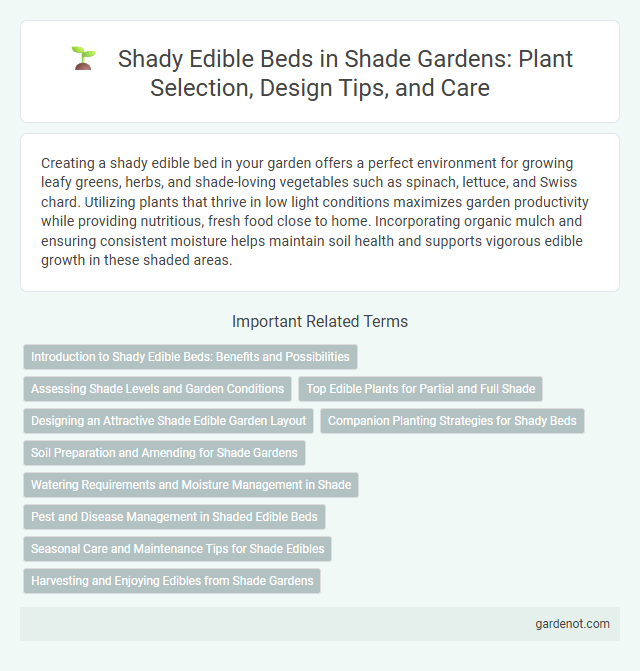Creating a shady edible bed in your garden offers a perfect environment for growing leafy greens, herbs, and shade-loving vegetables such as spinach, lettuce, and Swiss chard. Utilizing plants that thrive in low light conditions maximizes garden productivity while providing nutritious, fresh food close to home. Incorporating organic mulch and ensuring consistent moisture helps maintain soil health and supports vigorous edible growth in these shaded areas.
Introduction to Shady Edible Beds: Benefits and Possibilities
Shady edible beds maximize garden space by growing shade-tolerant vegetables and herbs such as spinach, kale, and mint, which thrive under limited sunlight. These beds improve soil health through diversified planting and reduce water evaporation, creating sustainable food sources in low-light environments. Utilizing shaded areas helps gardeners expand food production while enhancing biodiversity and nutrient availability.
Assessing Shade Levels and Garden Conditions
Assessing shade levels in a shady edible bed involves measuring the duration and intensity of sunlight, typically using light meters or observation throughout the day. Garden conditions, including soil moisture, pH, and nutrient content, must be tested to ensure optimal growth for shade-tolerant crops like leafy greens, herbs, and root vegetables. Understanding microclimates within the shade garden helps select appropriate edible plants that thrive under varying light and soil conditions.
Top Edible Plants for Partial and Full Shade
Hostas, ferns, and leafy greens like spinach and Swiss chard thrive in shady edible beds, making them ideal for partial to full shade gardens. Mushrooms and certain herbs such as mint and parsley also flourish under low-light conditions, providing a variety of edible options. Shade-tolerant crops optimize garden space while ensuring nutrient-rich harvests in areas with limited sunlight.
Designing an Attractive Shade Edible Garden Layout
Designing an attractive shade edible garden layout involves selecting shade-tolerant crops such as leafy greens, herbs, and root vegetables that thrive in low-light conditions. Incorporate layered plantings with tall, shade-giving species like ferns or hostas to create microclimates that enhance growth and visual interest. Use curved pathways and varied textures to maximize space and aesthetic appeal while ensuring easy access for maintenance and harvesting.
Companion Planting Strategies for Shady Beds
Companion planting in shady edible beds enhances growth by selecting shade-tolerant plants that mutually benefit each other, such as leafy greens like spinach and Swiss chard paired with herbs like mint and chives. Incorporating nitrogen-fixing plants like legumes improves soil fertility, while deep-rooted companions help aerate the soil, promoting root health in shaded conditions. Strategic placement of plants with varying heights maximizes light absorption and reduces pest issues, optimizing productivity in shade gardens.
Soil Preparation and Amending for Shade Gardens
Shady edible beds require well-draining, nutrient-rich soil amended with organic matter such as compost, leaf mold, or aged manure to improve moisture retention and fertility. Incorporating materials like pine needles or shredded bark can help maintain the slightly acidic pH preferred by many shade-tolerant edibles. Regular soil testing guides the balanced addition of amendments, ensuring optimal nutrient availability for healthy plant growth in low-light conditions.
Watering Requirements and Moisture Management in Shade
Shady edible beds require consistent moisture retention without waterlogging to support the growth of shade-loving vegetables like leafy greens and root crops. Implementing drip irrigation or soaker hoses ensures even watering, reducing evaporation and promoting deep root development in shaded conditions. Mulching with organic materials helps maintain soil moisture levels, regulates temperature, and minimizes weed competition in the shaded garden environment.
Pest and Disease Management in Shaded Edible Beds
Effective pest and disease management in shaded edible beds relies on selecting shade-tolerant, pest-resistant plant varieties and maintaining proper airflow to reduce humidity-related diseases. Regular inspection for common pests such as slugs, aphids, and fungal infections helps prevent infestations before they escalate. Organic treatments like neem oil or insecticidal soap minimize chemical use while promoting a balanced ecosystem within the shade garden.
Seasonal Care and Maintenance Tips for Shade Edibles
Shade edible beds require careful seasonal care to ensure healthy growth and bountiful harvests. In spring, enrich the soil with organic compost and mulch to retain moisture and suppress weeds, while pruning shade trees to maximize indirect sunlight. During fall, remove dead foliage, test soil pH for acidity adjustments, and protect delicate plants from frost with appropriate coverings.
Harvesting and Enjoying Edibles from Shade Gardens
Harvesting from a shady edible bed requires careful timing to ensure peak flavor and nutrient retention, particularly for leafy greens like spinach, kale, and Swiss chard that thrive in low-light conditions. Regularly picking tender leaves promotes continuous growth, while root vegetables such as beets and radishes benefit from cooler, shaded environments that extend their growing season. Enjoying shade garden edibles fresh enhances taste profiles and allows gardeners to savor nutrient-rich produce that flourishes outside full sun exposure.
Shady edible bed Infographic

 gardenot.com
gardenot.com